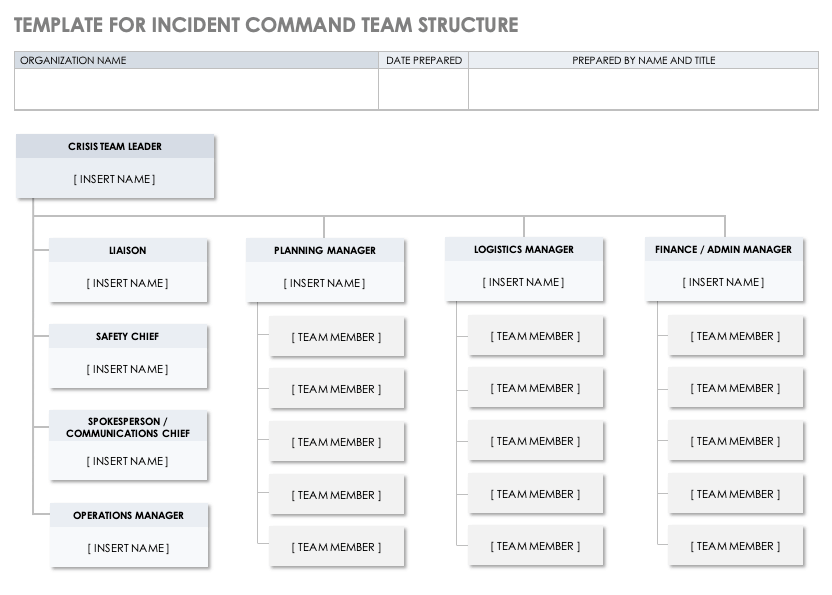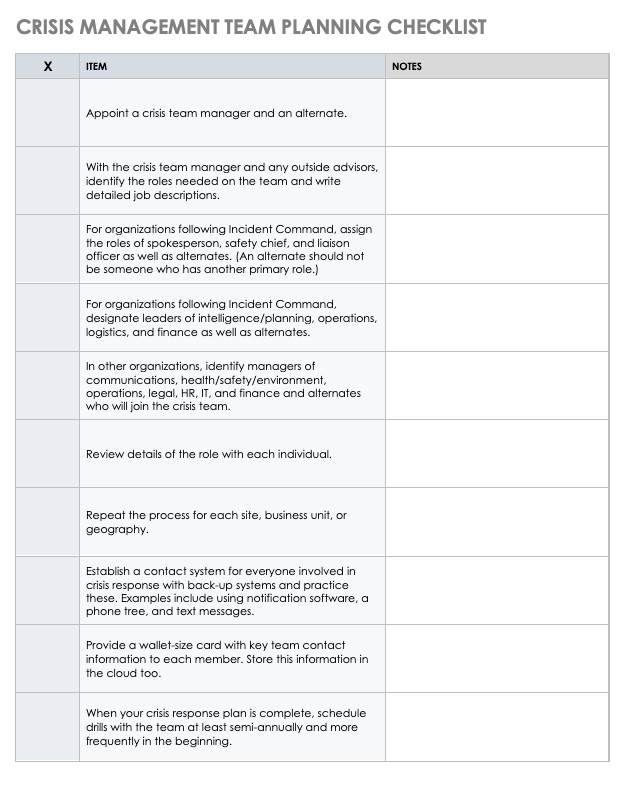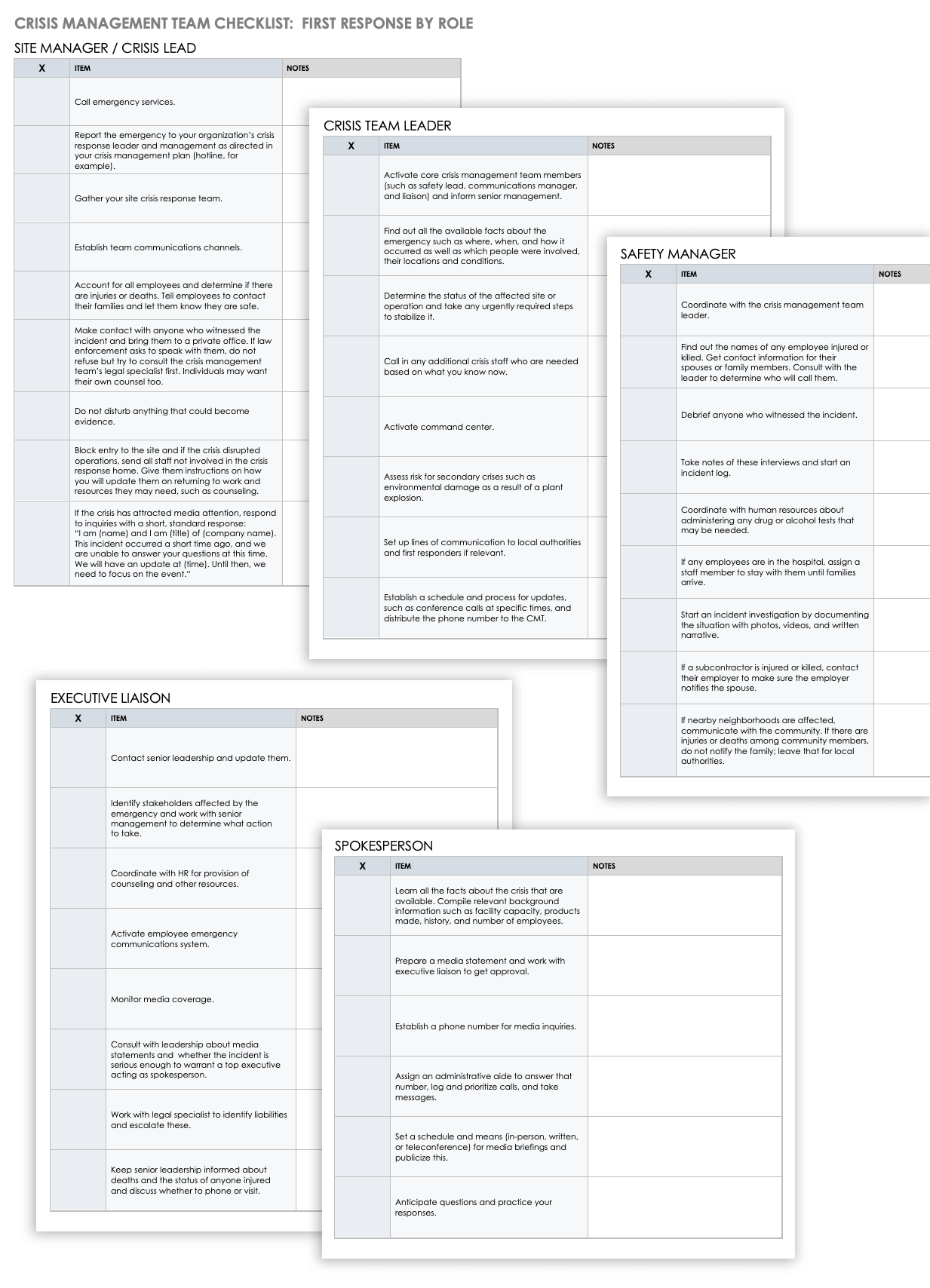What Is a Crisis Management Team?
A crisis management team, also known as a CMT, incident management team, or corporate incident response team, prepares an organization to respond to potential emergencies. It also executes and coordinates the response in the event of an actual disaster.
The crisis management team has a designated leader, and other team members are assigned particular responsibilities, such as planning or logistics. Together, this team has the authority to make decisions under dire circumstances.
Large organizations may need to designate a lead crisis management team and corresponding subteams (each with its own leader) that focus on specific work streams or geographies. Depending on the severity and type of crisis, you may not need to activate all roles in every crisis.
Members of a crisis team are usually employees who hold other positions in the organization; often, team members are human resources managers, heads of departments, senior managers, public relations representatives, communications and marketing executives, key operational staff, and site managers. We discuss crisis management roles and responsibilities below.
The Purpose of a Crisis Management Team
The crisis management team exists to help an organization minimize or possibly avoid a calamity and, if disaster strikes, to recover as quickly as possible with minimal negative repercussions. No business is immune to crisis, so every company needs to understand the basics of crisis management. This crisis management essential guide provides an overview of the topic and insights from leading experts.
For helpful crisis management templates such as for plans and playbooks, read “Free Crisis Management Templates.”
The crisis management team’s responsibilities vary by phase. In the planning stage, the CMT does the following:
- Analyze potential risks and the organization’s vulnerabilities.
- Talk to stakeholders at all levels, both inside and outside the organization, about their needs and concerns.
- Identify resources available and needed to respond to a crisis.
- Develop a detailed crisis management plan. (You can learn how to develop a crisis management plan in “Step-by-Step Guide to Writing a Crisis Management Plan.”)
- Obtain any missing resources.
- Train all employees on what to do in a crisis.
In the crisis phase, the team is responsible for the following:
- Monitor and detect early signs of an emergency.
- Assess the impact of the crisis.
- Activate the crisis response and the crisis command system.
- Implement emergency measures and contingency plans.
- Communicate important information to all stakeholders.
- Arrange support services, such as first aid, mental health resources, and food.
- Support morale.
- Coordinate with senior management.
In the aftermath of a crisis, the team does the following:
- Review what did and didn’t work well.
- Revise the crisis management plan, based on this new learning.
- Replenish resources and obtain any new needed resources.
- Communicate changes to stakeholders.
- Hold drills and rehearsals of the revised plan across the organization.
- Update the plan as required by changes in the organization or threat landscape.
Crisis Management Roles and Responsibilities
Crisis management teams need a leader and members with communications, finance, administrative, and operations or business unit experience. Recruit members from human resources, information technology, legal, risk/security, facilities, product, or sales. Consider assigning one member to work with executives.
In a large crisis management team, an individual may be in charge of each area of responsibility, but members of smaller teams may fill more than one role. Typically, individuals represent the area of the organization in which they normally work, so they bring their operational knowledge to the crisis management team.
During normal operations, many departments often have teams that deal with problems. In an organizational crisis, this team becomes a subteam of the crisis management team and reports to the individual in the related role.
For example, IT departments generally have a group that responds to outages or other urgent technical problems as part of their normal routine. In a major emergency that affects the whole organization, this group activates as part of the crisis response, with the IT member in charge.
Regina Phelps is the founder of crisis management consulting firm Emergency Management & Safety Solutions, whose clients have included Microsoft, Duke University, and Airbnb. She explains that executive management leads the strategic response, including policy decisions, while a team of managers from major organizational departments leads the tactical response.
The organization chart below reflects this basic structure, in which responsibilities are divided between the crisis management team that handles the incident response and the executive management that oversees strategic issues.
As part of crisis planning, write a job description for each crisis management team member. (See below for details of each role.) And make sure to identify a backup or alternate person for each role, in case a team member is on vacation or caught in the crisis.
Team Structure in Incident Command System of Crisis Management
The Incident Command System is a crisis management model that began in government and spread to the private sector. For details on this model and other theories of crisis management, see “Models and Theories to Improve Crisis Management.”
In this crisis management team structure, the incident commander or command team oversees the crisis response and four subteams (or, in small organizations, individuals instead of subteams).
The subteams have their own leaders and are in charge of operations, planning and intelligence, logistics, and finance. Below are details of each subteam, an action that best sums up the area of responsibility, and the departments that the subteam draws from:
- Command (manages)
- Manage overall crisis response.
- Determine priorities and objectives.
- Direct and control group.
- Obtain resources.
- Coordinate with executive leadership.
- Settle disputes and conflicts.
- Take direction from the incident commander.
- The team includes a spokesperson, a safety chief, and an executive liaison.
- Operations (does)
- Handle the tactical operations in the crisis response.
- Perform initial damage assessment.
- Oversee frontline responders.
- Establish control over the situation.
- Compile status reports.
- Seek to restore the business or operation to normal.
- Include key areas of operations, such as facilities, security, IT, safety, and real estate.
- Planning and Intelligence (plans)
- Gather, analyze, and share information on the crisis.
- Assess status reports.
- Recommend action.
- Include business continuity staff, corporate communications, legal, investor relations, and representatives of key lines of business.
- Logistics (cares)
- Support human needs, such as food, shelter, transportation, medical care, and counseling for the crisis team and the organization.
- Team includes representatives from HR, travel department, meeting services, and employee assistance program.
- Finance (pays)
- Track and document all costs and expenditures of the crisis response.
- Handle payroll, emergency purchase orders, cash needs, and purchasing cards.
- Coordinate with insurance on claims and worker’s compensation.
- Provide administrative support.
- Team includes finance, risk, insurance, payroll, treasury, and procurement functions.
This organizational chart reflects a large crisis management team under this system.
To create your own team structure using this model, download the following template, which lays out all the potential roles and their hierarchy and provides space for you to fill in team member names.
Download Template for Incident Command Team Structure
The Role of the Crisis Manager
The leader of the crisis management team has ultimate authority over the team and its work. The team leader oversees crisis planning and response, keeps the effort on track, and makes major decisions.
For the leader to be effective, senior executives, the board of directors, and other powers in the organization must fully back the leader in this role and support the decisions the leader makes. In this way, the crisis manager role exists partially outside the normal organizational hierarchy.
While not typically from the C-suite, the crisis response manager holds major decision-making power during an emergency and may give direction to superiors. Executives need to give this kind of authority to the crisis manager to speed the emergency response. Otherwise, second-guessing and overmanagement by the C-suite could bog down the crisis effort.
In addition, if the crisis involves internal malfeasance or executive impropriety, the chain of command may need to change further and circumvent the people involved in the incident.
If the crisis management team does not have a designated liaison to senior management, the crisis team leader often fulfills the function.
The crisis manager’s role includes the following:
- Hold responsibility for implementing the crisis management plan.
- Develop the crisis team and make sure it is ready.
- Monitor and mitigate risks.
- Assess an emergency.
- Declare a crisis and activate the crisis plan.
- Take command of the crisis response.
- Evaluate options, identify problems, and build a strategy.
- Ensure the safety of employees, facilities, and stakeholders.
- Regularly update leadership on the crisis response.
Crisis Management Team Roles
Crisis management teams must handle all dimensions of the crisis. The team needs members who bring knowledge of different fields and areas of responsibility.
If the organization lacks people with the necessary expertise, during the planning phase, consider how you can fill these gaps. You might identify advisors and agencies that can step in or provide additional staff in an emergency and agree to a formal contingency plan with them.
Deborah Hileman, President and CEO of the Institute for Crisis Management, recommends that the core crisis management team includes key functions such as operations, security, IT, human resources, and communications.
“Other functions should be added as extensions of the core team as needed, depending on the nature of the crisis. For example, supply chain and purchasing management may be needed to support a crisis that impacts the procurement of goods and services for the enterprise,” she adds.
While the makeup of each team varies, depending on the organization and the threats it faces, some common additional roles include the following:
- Security Manager: Is responsible for evaluating security provisions of the crisis management plan and handling site security during a crisis.
- Spokesperson/Public Affairs Advisor: Briefs the media, handles communications, and forms messaging strategy.
- Human Resources Manager: Maintains information on all staff, including after-hours contact details and location, and keeps track of benefits, such as health and life insurance.
- Health, Safety, and Environment Lead: Manages risks to personnel health and safety and to unplanned environmental impact, provides training for emergency response, handles damage assessment, and oversees these areas during a crisis.
- Legal Specialist: Advises company on legal and regulatory liabilities and steps to mitigate negative impact, vets outgoing information, prepares anyone who is interviewed by an external body, and manages sharing of confidential information.
- Command Center Manager: Is responsible for maintaining the command center, making sure it has all necessary equipment, supplies, and utilities; keeping it stocked and clean during a crisis; and fixing any breakdowns.
- Operations and Business Recovery Manager: Provides input on how to shut down and restore operations in an emergency, and during a crisis coordinates efforts of staff working on business recovery.
- Administrative Support Staff: Aids the crisis team by taking notes, tracking action points, handling documents, and providing knowledge on the organization and how it works.
- Information Technology Manager: Provides IT expertise to the planning process and leads the IT crisis response.
- Finance Officer: In crisis planning, sets up contingency arrangements for emergency financial resources; in a disaster, manages cash disbursements and credit cards, decides if financial reports will be delayed, informs insurers, and gathers documentation for major claims. (Employee-related claims fall under HR.)
- Business Unit Representative: Plans for a crisis in their business unit, represents their unit to the crisis management team, and can activate additional staff when needed (this role may overlap with operations managers).
- Subject Matter Experts: Varies by type of organization and brings specialized expertise as required.
An organization chart shows how these roles fit together and the chain of command in an organization not using the Incident Command Structure.
Attributes of Crisis Management Team Members
The effectiveness of the crisis response depends partly on the strengths of the individuals who make up the team. Team members should have the following characteristics:
- Understand the big picture of the organization.
- Effectively advocate for his or her department or area of responsibility.
- Be a good collaborator.
- Be a strong communicator.
- Handle pressure well.
- Think quickly and analytically.
The team leader, sometimes called the incident commander, must have all the above attributes and should also have the following characteristics:
- Be a strong leader.
- Make decisions quickly and effectively.
- Be respected by colleagues and executive leadership.
- Be a strong multitasker.
- Be able to bridge differences among different personalities.
- Be a good delegator.
What Role Should the CEO Play in Crisis Management?
The most senior person in the organization, such as the CEO or president, is rarely in charge of crisis response (or even a part of the crisis team). Instead, they should play a strategic role. For more about crisis management strategy, see “How to Craft a Strong Crisis Management Strategy.”
“You must have a strategic and tactical response to crisis management,” says Phelps. She notes that the strategic duties of the CEO in a crisis are extensive and complex, and handling these leaves the top executive with insufficient time to join the operational response. “The tactics of managing the crisis are simple by comparison,” she explains.
The organization’s leader has four primary strategic duties in an emergency:
- Direct strategy and policy.
- Oversee financial strategy and extraordinary spending.
- Manage important relationships with employees, investors, customers, and government regulators.
- Act as a media spokesperson when the crisis is very serious or when recommended by the communications leader.
“Depending on the level of the situation, an executive may be needed to serve as the spokesperson and the face of the issue. In general, the CEO is reserved for situations that involve death, dismemberment, and complete closure of the business. Overall, the senior executive speaking on the situation should be the one closest to the matter, with a title that conveys authority and confidence.” notes D. Nikki Wheeler, a veteran in corporate crisis communications and author of media playbook “See. Spot. Run.”
Crisis Management Team Checklist
When you begin crisis planning, forming the crisis management team is one of your most important priorities. Follow a checklist to make sure you don’t miss any key steps, as this phase sets the stage for the detailed crisis planning to follow.
Crisis Management Team Planning Checklist
Appoint a crisis team manager and an alternate. - With the crisis team manager and any outside advisors, identify the roles needed on the team and write detailed job descriptions.
- For organizations following Incident Command, assign the roles of spokesperson, safety chief, and liaison officer, as well as alternates. (An alternate should not be someone who has another primary role.)
- For organizations following Incident Command, designate leaders of intelligence and planning, operations, logistics, and finance, as well as alternates.
- In other organizations, identify managers of communications; health, safety, and environment; operations; legal; HR; IT; and finance, as well as alternates who will join the crisis team.
- Review details of the role with each individual.
- Repeat the process for each site, business unit, or geography.
- Establish a contact system for everyone involved in crisis response with backup systems and practice your plans. Examples include using notification software, a phone tree, and text messages.
- Provide a wallet-size card with key team contact information to each member. Store this information in the cloud too.
- When your crisis response plan is complete, schedule drills with the team at least semi-annually and more frequently in the beginning.
This checklist guides you through these steps and provides space for you to fill in the names of your team members and alternates.
Download Crisis Management Team Planning Checklist
Word | PDF I Smartsheet
When a crisis erupts, adrenaline often runs high, and crisis team members benefit from being able to refer to the crisis management plan and a checklist of the very first actions they need to take.
Crisis Management Team Checklist: First Response by Role
This checklist lists key actions for the immediate aftermath of a crisis for each team member according to their role. The template allows you to customize the checklist and mark off items as you go.
- Site Manager/Crisis Lead
- Call emergency services.
- Report the emergency to your organization’s crisis response leader and management as directed in your crisis management plan (hotline, for example).
- Gather your site crisis response team.
- Establish team communications channels.
- Account for all employees and determine if there are injuries or deaths. Tell employees to contact their families and let them know they are safe.
- Make contact with anyone who witnessed the incident and bring them to a private office. If law enforcement asks to speak with them, do not refuse, but try to consult the crisis management team’s legal specialist first. Individuals may want their own counsel too.
- Do not disturb anything that could become evidence.
- Block entry to the site, particularly if the crisis disrupted operations. Send all staff who are not involved in the crisis response home, and give them instructions on how you will update them on returning to work and resources they may need, such as counseling.
- If the crisis has attracted media attention, respond to inquiries with a short, standard response: “I am (name) and I am (title) of (company name). This incident occurred a short time ago, and we are unable to answer your questions at this time. We will have an update at (time). Until then, we need to focus on the event.”
- Crisis Team Leader
- Activate core crisis management team members (such as safety lead, communications manager, and liaison) and inform senior management.
- Find out all available facts about the emergency, such as where, when, and how it occurred, as well as which people were involved, their locations, and their conditions.
- Determine the status of the affected site or operation, and take any urgently required steps to stabilize it.
- Call in any additional crisis staff who are needed based on your knowledge of the situation at the moment.
- Activate the command center.
- Assess risk for secondary crises, such as environmental damage as a result of a plant explosion.
- Set up lines of communication to local authorities and first responders when relevant.
- Establish a schedule and process for updates, such as conference calls at specific times, and distribute the phone number to the CMT.
- Safety Manager
- Coordinate with the crisis management team leader.
- Find out the names of any employee who was injured or killed. Get contact information for their spouses or family members. Consult with the leader to determine who will call them.
- Debrief anyone who witnessed the incident.
- Take notes of these interviews and start an incident log.
- Coordinate with human resources about administering any drug or alcohol tests that may be needed.
- If any employees are in the hospital, assign a staff member to stay with them until families arrive.
- Start an incident investigation by documenting the situation with photos, videos, and written narrative.
- If a subcontractor is injured or killed, contact their employer to make sure the employer notifies the spouse.
- If nearby neighborhoods are affected, communicate with the community. If there are injuries or deaths among community members, do not notify the family; leave that for local authorities.
- Spokesperson
- Learn all the facts about the crisis that are available. Compile relevant background information, such as facility capacity, products made, history, and number of employees.
- Prepare a media statement and work with the executive liaison to get approval.
- Establish a phone number for media inquiries.
- Assign an administrative aide to answer the number for media inquiries, log and prioritize calls, and take messages.
- Set a schedule and means (in-person, written, or teleconference) for media briefings and publicize this information.
- Anticipate questions and practice your responses.
- Executive Liaison
- Contact senior leadership and update them on the proceedings.
- Identify stakeholders affected by the emergency and work with senior management to determine what action to take.
- Coordinate with HR for provision of counseling and other resources.
- Activate employee emergency communications system.
- Monitor media coverage.
- Consult with leadership about media statements and whether the incident is serious enough to warrant a top executive acting as spokesperson.
- Work with a legal specialist to identify and escalate liabilities.
- Keep senior leadership informed about deaths and the status of anyone injured, and discuss whether to phone or visit.
Download Crisis Management Team Checklist: First Response by Role
Word | PDF I Smartsheet
How Crisis Management Teams Adapt to Multiple Locations
If your company has multiple sites, you must prepare for how the downstream effects of a single emergency could potentially affect all of them, both as individual sites and in different combinations. The crisis team model adapts by establishing a team that parallels the main team at each site and geographic unit.
The site team mirrors the structure of your lead team, although individual team members are more likely to play more than one role at small sites. Use the same system as your lead team to ease the coordination and exchange of information — the structure clearly identifies the counterparts for each area of responsibility, which will help you to quickly respond and send resources, if needed.
Large national and multinational organizations also typically have a hierarchy of crisis teams at the executive, corporate/regional, country/subregion, district, and site levels. In this structure, the leader of the crisis response may be a regional manager, the head of a business unit, or a local facilities manager.
Each team in this model has response responsibility for specific crises and an oversight or support role in those at the lower levels. In addition, each level may escalate issues that are sensitive or urgent to a higher-level team to bring management attention to the problem.
Team Level | Manages | Coordination | Notes |
|---|---|---|---|
Executive | Global- or executive-level crisis | Monitors lower-level crises | Is made aware of highly sensitive issue at any level |
Corporate/Regional | Unit or multicountry crisis | Monitors lower-level crises | Ensures consistency of communication at regional level |
Country/Subregion | National or multistate crisis | Supports lower-level crises | Interfaces with national government |
District | Statewide or multisite crises | Supports site team, informs country team | Interfaces with state government |
Site | Site crisis | Informs district support team | Provides tactical response, works with local public emergency response |
This organization chart maps out this structure of crisis management in an organization with multiple sites.
As with this example, if your organization does not have all the geographic units described above, you can combine the executive responsibilities with those of the team managing your broadest area, such as one handling national or statewide emergencies.
Crisis Management Support Teams
In addition to this hierarchical structure based on geography, you can create functional crisis support teams. These teams are responsible for specific areas of the business, and they implement continuity and recovery plans or with specialized expertise such as in IT or legal affairs.
Culture and Mindset Problems that Defeat the Crisis Management Team
Organizational problems can impede the crisis management team. The effectiveness of your crisis response will largely depend on the organization’s culture, which is shaped by leadership. The team needs senior management to have a true, ongoing commitment to preparedness and not just pay lip service.
When management and the organization are in denial about threats and vulnerabilities, crisis planning is unlikely to be robust, and the company will probably not follow through on training and providing resources.
Sometimes, this reflects political issues, such as resistance to analyzing vulnerabilities because of the perception that doing so exposes embarrassing weaknesses in the organization or management. Or some companies mistakenly believe that having insurance makes crisis planning less necessary.
Michael Fagel, a veteran crisis management leader and instructor who is founder of Aurora Safety, an emergency response consulting firm, says that many organizations get lulled into believing that a crisis won’t happen to them. According to Fagel, some companies create a crisis management team and plan, only to let them become obsolete after time passes without a disaster.
To learn more about the effects of poor crisis management and communication, take a look at these crisis management examples.
Experts Troubleshoot Most Common Crisis Management Team Problems
Crisis management experts say they encounter a handful of repeated problems among teams that impair their effectiveness. Awareness and preventive action can alleviate these issues.
- Lack of Executive Support: Strong crisis response requires a never-ending effort to stay prepared, and many companies lose focus, especially if leadership is not committed. “Before COVID-19, executives were increasingly more comfortable taking on more and more risk without mitigating measures, teams, or plans,” says Phelps. “Or funding (for crisis response) would decrease over time because ‘nothing happened.’” To combat this neglect, regularly review with senior executives the potential impact of your most probable threats.
- Not Understanding Individual Responsibilities: Confusion among team members over crisis management roles and responsibilities can hurt the disaster response.
“The crisis management team should not have to debate its roles, responsibilities, and authority in the midst of a crisis,” notes Bryan Strawser, CEO of Bryghtpath LLC, a crisis management advisory firm, and former leader of Target Corporation’s crisis management and business continuity function.
Deborah Hileman of the Institute for Crisis Management recommends writing job descriptions for all team roles and conducting enough training that team members become comfortable in their positions.- Not Enough Joint Practice: Similarly, teams often stumble because they haven’t sufficiently practiced working together as a unit. They do not learn (or have since forgotten) procedures and the ways their functions mesh. This undermines speed and effectiveness.
“Crisis preparedness has a lot to do with muscle memory. Tabletop drills are critical and can really help an organization to work through the kinks in its processes,” says independent crisis consultant Abbe Serphos.- Lack of Action Orientation: Crisis teams lose their way when they get bogged down in analysis paralysis. Too often they “become an academic debating society,” says Strawser. “The crisis management team should be organized for action and led by an incident leader who … can push the team to make decisions and communicate the results of those decisions internally and externally.”
For examples of good and bad crisis management, see “The Most Useful Crisis Management Examples: The Good, Bad, and Ugly.”
Master Remote Crisis Management with Real-Time Work Management in Smartsheet
Empower your people to go above and beyond with a flexible platform designed to match the needs of your team — and adapt as those needs change.
The Smartsheet platform makes it easy to plan, capture, manage, and report on work from anywhere, helping your team be more effective and get more done. Report on key metrics and get real-time visibility into work as it happens with roll-up reports, dashboards, and automated workflows built to keep your team connected and informed.
When teams have clarity into the work getting done, there’s no telling how much more they can accomplish in the same amount of time. Try Smartsheet for free, today.








